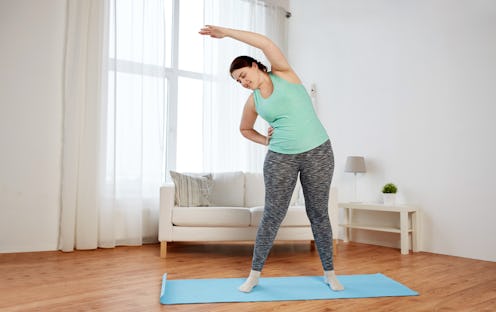Life
8 Hacks To Make Your Yoga Routine Actually Stick

Getting a yoga or meditation routine going is not as easy as Instagram can make it seem. Many of us say we want to incorporate yoga or meditation into our daily routines, but putting that into practice and maintaining it for the long haul isn't always that simple. Beginning any new activity almost always comes with a learning curve, but before you quit yoga and meditation for good, there are a few tricks to know to help you start a yoga routine and actually make it stick.
There's no denying that in recent years, yoga and meditation have become trendy activities. But there's a reason behind it: Studies have shown regular meditation can help with anxiety, improve your concentration for years, ease pain, and boost your cognitive health overall. Recent studies even suggest meditation can improve your sex life by cranking your orgasms up a notch (yes, for real!). Yoga also has brain-boosting effects, releases endorphins, and can even reduce levels of inflammation in the body.
So, as difficult as meditation and yoga can feel when you're a beginner, the health benefits of these practices you can do at home, or in a class, definitely make trying to get them down worth it. If you're struggling with establishing yoga and meditation as a daily practice, here are 8 tips from experts that will help get you started.
1Start With Short Sessions
If you're new to mindfulness and meditation, you don't have to dive into an hour-long yoga sesh right off the bat. Erin Berman, the lifestyle and wellness expert at Nectar Sleep, tells Bustle that starting small is actually a good idea if you want to make yoga or meditation a part of your regular routine.
"The key to building a new meditation, breath work and/or yoga practice is consistency and cultivating a balanced practice," she explains. "Commit to a few times a week to ease yourself in — and maybe only five to 10 minutes at a time."
2Schedule In Your Yoga Or Meditation
Busy schedule? Try to set aside a little block of time each day where you can get in the zone, and begin to establish your routine. "Find a time of day you can set for yourself with minimal distraction," suggests Tova Sklar, the yoga expert for Gaiam. "Set a timer and either shut your phone off or silent it, wait until you can be alone for a few moments, and use that time wisely."
3Strike A Balance
Berman says that while you may be excited to jump into a full-fledged yoga routine five times a week, finding a good balance that works with your existing schedule is the best way to avoid feeling burnout in the long run. "Practice at a pace that works for your lifestyle and goals, and be mindful to start in a way that allows you to build over time," she suggests.
4Get Set Up With Good Gear
If you have the funds, investing in decent yoga equipment or essential oils to set the mood can be key when jump-starting a new routine. Sklar explains that, "A great way to make yoga or meditation easier is to use props and a sturdy mat. During yoga, use a non-slip mat to keep you in place [...] and a yoga block to help your body stabilize in tougher positions."
5Begin With A "Gentle" Form Of Yoga
If your goal is to eventually attend a weekly Bikram yoga (aka, hot yoga) class, it's probably best to start out with a practice that's a little more forgiving on beginners. "I suggest Yoga Nidra for anyone looking for deep rest and relaxation while also learning some mindful techniques. This is guided meditation while laying down; you can do it first thing in the morning, or before falling asleep," Berman explains. "Other gentle yogas such as yin yoga, or a vinyasa flow will also be easier to work on stretching and postures."
6Or, Try An Array Of Classes And Styles
Another option is to switch up your yoga style until you find one that resonates with you. "Nowadays there is access to so many different styles of yoga, so many different types of teachers. I’m always telling people who are inquiring that if you take a class and you don’t like it, go out and find another," explains Sklar.
7 Don't Expect Perfection
Watching a yoga instructor effortlessly move through a yoga flow can make it seem easy. However, it can take time to cultivate mindfulness, improve your posture, and to find a practice that works for you personally. "The most important thing in yoga or meditation is to always have the 'beginners mind,' which is a way of saying to release that we are every progressing to a destination, or becoming very advanced," Berman says.
She adds that yoga shouldn't just be about trying to make it to the next milestone, but rather, "It's about feeling present while connecting your body and breath."
8And, Try To Be Less Critical Of Yourself
Being overly critical of yourself can impede your progress when it comes to most things — including yoga and meditation. Berman says to "avoid beating yourself up" if your routine doesn't go as planned, and to "be kind, gentle and compassionate on yourself as you begin a new routine." Even the most committed meditators struggle with their routine from time to time, so try to be less negative about your missteps along the way.
Working yoga or meditation into your daily life can be a bit challenging when you're a newbie, but, using some of these expert-approved hacks can make is much easier to get your routine going.